

Designio ecodesign - Photos. Normas da biosfera - Harvard Business Review Brasil. 8 Biomimicry Examples Taken From Actual Startups. Only Biomimicry Will Save Cybersecurity. Janine Benyus: What Businesses Can Learn from the 'Optimization Engine of Evolution' Humpback whale image credit: Mary Schwalm/Reuters / WhalePower's wind turbine blade, designed to mimic the tubercles (bumps) on a humpback's flippers | Image credit: WhalePower Corporation In 1997, biologist Janine Benyus popularized the term “biomimicry,” with her groundbreaking book of the same name, and spearheaded the growth of the discipline dedicated to applying Nature’s designs and processes to create a healthier, more sustainable world.
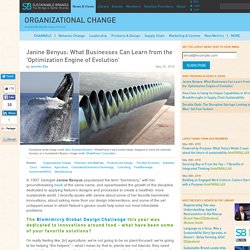
I recently spoke with Janine about some of her favorite biomimetic innovations, about asking more from our design interventions, and some of the yet untapped areas in which Nature’s genius could help solve our most intractable problems. The Biomimicry Global Design Challenge this year was dedicated to innovations around food - what have been some of your favorite solutions?
One is called the living filtration system - they created a lining within drainage pipes for large-scale drainage systems - for cornfields in the Midwest, for example. Landscape+Urbanism. Since reading Janine Benyus’ book Biomimicry back in 1997, I’ve been simultaneously fascinated and frustrated by the conceptual positioning and posturing of the proponents of biomimicry.
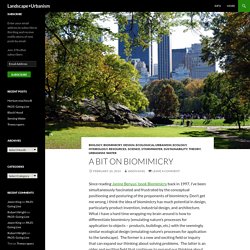
Don’t get me wrong, i think the idea of biomimicry has much potential in design, particularly product invention, industrial design, and architecture. What i have a hard time wrapping my brain around is how to differentiate biomimicry (emulating nature’s processes for application to objects – products, buildings, etc.) with the seemingly similar ecological design (emulating nature’s processes for application to the landscape). The former is a new and exciting field or inquiry that can expand our thinking about solving problems. The latter is an older and exciting field that continues to expand our thinking about solving problems. How Nature Can Inspire New Technologies. Learning from the information network of life - Circulate. Life is network based.
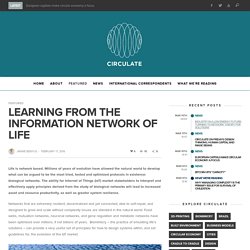
Millions of years of evolution have allowed the natural world to develop what can be argued to be the most tried, tested and optimized protocols in existence: biological networks. The ability for Internet of Things (IoT) market stakeholders to interpret and effectively apply principles derived from the study of biological networks will lead to increased asset and resource productivity, as well as greater system resilience.
Biomimicry 3.8 on systems thinking: Nature-inspired business lessons. GCP Arquitetura & Urbanismo. Erika Hanson. How nature says it. ASU Online Master's Degree. Chris Allen, MBA Former CEO of Biomimicry Group, working full-time on applying biomimicry to the built environment with projects globally.
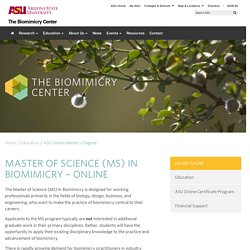
Karen Allen, MS Faculty with Biomimicry 3.8. Freelance consultant biologist and full-time biomimic. Melina Angel Founder of Biomimicry Quebec and Biomimicry Columbia. Representing Canada in ISO process for biomimetic standards. Zeynep Arhon, MBA Faculty with Biomimicry 3.8. Biomimicry-Online Master's of Science. 30 credit hours including a portfolio of at least three practicum courses.
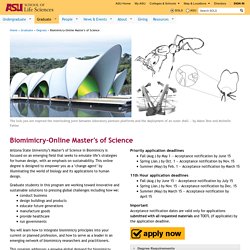
Core Courses (13 required) BMY 501 Essentials of Biomimicry (1)BMY 502 Life’s Principles (4)BMY 503 Biology Taught Functionally (4)BMY 504 Biomimicry Thinking (4) Elective Courses (11 required) BMY 511 Biomimicry and Design (3)BMY 512 Biomimicry and Engineering (3)BMY 516 Biomimicry and Business (3)BMY 517 Human-Nature Connection (2)BMY 598 Special Topics: iSites (1)BMY 598 Special Topics: Communicating Biomimicry (1)BMY 598 Special Topics: Teaching Biomimicry (1)BMY 598 Special Topics: Facilitating Biomimicry (1)
Biomimicry. Virtual Design Lab: Four nature-inspired projects poised to make the world a better place. From developing an undergrad class to inspire biomimicry in business to creating an affordable prosthetic hand design that can be made from a 3D printer, we’re proud of the work our students are doing to bring biomimicry-based solutions to the world.
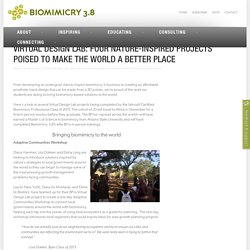
Here’s a look at several Virtual Design Lab projects being completed by the (almost) Certified Biomimicry Professional Class of 2015. The cohort of 20 will travel to Africa in November for a final in-person session before they graduate. The BPros—spread across the world—will have earned a Master’s of Science in biomimicry from Arizona State University and will have completed Biomimicry 3.8′s elite BPro in-person trainings. Adaptive Communities Workshop. 8th Annual Education Summit - Breakout Sessions – Biomimicry Institute. How to Implement a Successful K-12 Biomimicry Program – Lessons Learned Kelly Siman, PhD candidate at The University of Akron How do you implement a successful regional K-12 biomimicry program?
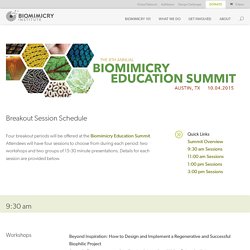
In Northeast Ohio (NEO), we’ve started to do just that. The University of Akron PhD Biomimicry program and Great Lakes Biomimicry are leading a collaborative effort of place-based innovation. The PhD Biomimicry Education Fellows work directly with schools and informal learning environments, such as local zoos and museums. Social Innovation… Nature’s Way. A SEED BANK OF INSPIRATION. What if companies and their buildings actually enhanced ecosystems? What if building codes actually required new projects to enhance a certain number of ecosystem services — such as sequestering carbon, building topsoil, enhancing pollination, increasing biodiversity or purifying water and air?
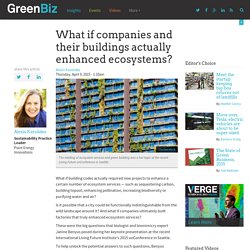
Is it possible that a city could be functionally indistinguishable from the wild landscape around it? And what if companies ultimately built factories that truly enhanced ecosystem services? These were the big questions that biologist and biomimicry expert Janine Benyus posed during her keynote presentation at the recent International Living Future Institute’s 2015 unConference in Seattle. To help unlock the potential answers to such questions, Benyus introduced the phrase “the adjacent possible,” or the evolutionary process that causes species to adapt to changes while allowing adjacent evolutions to become possible.
“Don't try to figure out what you did today, but what you made possible today,” Benyus said. Biomimicry NYC » 101 Ways Biomimicry Will Save the World. On Monday, April 13th, the BiomimicryNYC network helped Terrapin Bright Green launch their most recent white paper, “Tapping into Nature: The Future of Energy, Innovation and Business“.
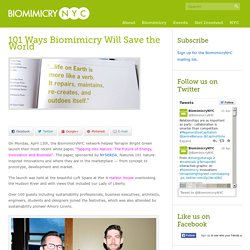
The paper, sponsored by NYSERDA, features 101 nature-inspired innovations and where they are in the marketplace — from concept to prototype, development and market. The launch was held at the beautiful Loft Space at Pier A Harbor House overlooking the Hudson River and with views that included our Lady of Liberty. Over 100 guests including sustainability professionals, business executives, architects, engineers, students and designers joined the festivities, which was also attended by sustainability pioneer Amory Lovins. Jonce Walker of Terrapin Bright Green with Benita Hussain of Bloomberg Philanthropies and Jonathan Simkins of American Express. The forecasted impact of bioinspired innovation in 2030.
How Would Nature Design A Company? BioInspired Business Book by Dr. Tamsin Woolley-Barker. The Biomimicry Manual: What Can Super-Organisms Teach Us About Collaboration? The ants and termites that make their homes in the desert are all ultra-social, spending their days coordinating carefully to build elaborate mounds and nests, farm fungus, herd aphids, and work together in busy cities—much like we do.

Biologists refer to all of us as “super-organisms”; groups where individuals don’t survive alone for long, everyone has a job to do, and the whole is more than the sum of its parts. Humans and ants must collaborate in order to survive: it’s in our nature. But people have only been noodling around this super-organismic experiment for a couple million years. Our societies are downright facile next to those of ants, who have been doing so for over 100 million years. Archive - Zygote QuarterlyZygote Quarterly. B-Collaborative. 6 Ways to Enlighten Yourself using Biomimicry. Humans have looked at nature for answers to problems since time immemorial. Our most important technologies are directly related to ways in which we have used nature as a model for our blueprints.
Biomimicry is a powerful way to cultivate the wisdom inherent in nature’s design. It sets a two-way mirror up against Mother Nature where we are more able to see ourselves and our interconnection with all things. Here are six ways we can use biomimicry to become more enlightened beings. 9th Annual Veracruz Biomimicry and Design Workshop – Biomimicry Institute. For the past nine years, biomimicry enthusiasts have flocked to Veracruz, Mexico, each summer to learn about biomimicry in a beautiful setting. Isn’t it time you joined in on the fun? Registration for the 9th annual Veracruz Biomimicry and Design Workshop is now open.
From July 8-18, join Biomimicry Institute staff and our affiliate partners at Universidad Iberoamericana and immerse yourself in the beauty of Veracruz State while learning about biomimicry with peers from all over the world. Exploration architecture - Exploration Architecture. The Biomimicry Institute – Inspiring Sustainable Innovation. AskNature. Biomimicry NYC » Crafting the Ultimate Post-Industrial Design Brief Using Biomimicry. By Adiel Gavish “What the industrial age has done is take life away from the planet and turn it into goods and services,” Paul Hawken stated at the 2014 VERGE Conference in San Francisco this past December. The annual event put on by Joel Makower, a former Biomimicry 3.8 Board Member and GreenBiz.com brings corporations and entrepreneurs together around the convergence of energy, buildings and transportation technologies which will “…enable radical efficiencies and huge opportunities.”
Mr. Makower interviewed both Janine Benyus and Paul Hawken around the idea of “running the industrial age backwards” and how nature can teach us how to undo the damage caused by unraveling the fabric of Earth’s balanced resources. Nature, Innovation and the Future of Design, Presented by Biomimicry Institute.